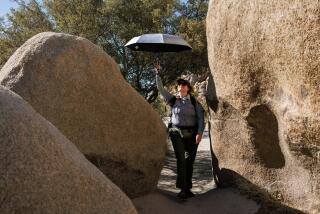Bring Your Own Boat : State Park, Unknown and Empty, Can’t Be Reached by Roads
AHJUMAWI LAVA SPRINGS STATE PARK, Calif. — While nearly all state and national parks are full of people this time of year, Ahjumawi is empty.
“I’m often the only person in the park,” said Steve Moore, 39, the ranger at this, the least-visited state park in California and the only one accessible exclusively by water.
Ahjumawi Lava Springs State Park is embraced by towering mountains, 6,000 acres of pine, oak and juniper forest, plus spectacular lava flows and one of the largest systems of fresh water springs in America.
The eight-mile southern park boundary is a chain of lakes, a favorite stop for thousands of migratory birds.
It was 13 years ago that the state purchased the pristine parcel from Ivy Horr, widow of rancher-lumberman Harry Horr, for $1 million.
But it wasn’t until 1984 that a ranger was assigned to California’s northeastern most and most remote state park on a year-round basis. Moore, 39, a ranger with the state park system for 16 years, is Ahjumawi’s first permanent caretaker.
“There are no signs posted telling the park’s location. It’s difficult to get to and few know of its existence,” explained Moore. “That’s why only a handful of people have ever visited the park. It’s just beginning to appear on maps.”
Rental Boats Not Available
Ahjumawi is accessible only by boat, but visitors have to bring their own. Rental boats are not available.
A 3 1/2-mile dirt road north out of the tiny town of McArthur, 75 miles northeast of Redding, leads to a landing on Big Lake.
The park is named after a small band of Indians who have lived in the area thousands of years, according to stories handed down from one generation to the next.
Ahjumawi means “where the waters come together.”
In 1910 there were 1,000 Ahjumawis in Fall River Valley between the park and McArthur. Today there are about 200 in the area.
“For us the park is a very special place,” said Floyd Buckskin, 35, member of the Ahjumawi Tribal Council who has worked closely with Moore on an inventory of Indian cultural resources here.
“There are old Ahjumawi house foundations, burial grounds, religious sites and sacred places within the park. For centuries and continuing to the present our people have gathered plants and berries and willows for basket weaving within the boundaries of the present park.”
Ahjumawis have special permission from the State Fish and Game Department to spear sacramental sucker fish in prehistoric rock fish traps along the shoreline of the park.
The sacramental sucker is considered trash fish by nearly everyone but the Ahjumawis. For them it is a delicacy. “We think of the sucker fish as a special gift from the Creator. If we lose that we have lost everything,” said Buckskin. The Indians eat the entire fish--head and all.
Buckskin and other members of the Ahjumawi Tribal Council have hopes of entering into a cooperative agreement with the state to cover use of the park.
“We have suggested that a stewardship program be established by having some of the Ahjumawis live year-round in the park to demonstrate to visitors many of the traditions of our people and to care and protect our cultural sites,” noted Buckskin.
There is an abandoned century-old two-story frame farmhouse and barn and a 19th-Century trappers’ cabin in the park but no other structures. The nine primitive campsites put in three years ago are seldom used.
Wildlife Abundant
Wildlife is abundant in the dense woods, including deer, bald eagle, osprey, great blue heron, great horned owls, rattlesnakes and coyotes. Hikers follow prehistoric Indian trails through the woods.
Moore, his wife, Ann, and their two sons, Jeffery, 11, and Jason, 9, live in Burney, 20 miles from the park.
Plans are to establish a park headquarters and visitor center in Ahjumawi in the future and a ranger residence there. But all that will happen after the State Department of Parks and Recreation comes up with a master plan for the park.
“The master plan is a long ways off,” said Moore. “The state is not even close to making any firm decisions on how to develop the park.”
Moore spends most of his time cataloguing resources, taking notes on wildlife, plants, the geology, hydrology, cultural resources and helping to introduce the park to the few that venture to this remote corner of California.
“As the park becomes better known, more and more people obviously will discover it. But for now, it is the only state park in California that one can come to and be the only visitor,” the ranger said.
More to Read
Sign up for The Wild
We’ll help you find the best places to hike, bike and run, as well as the perfect silent spots for meditation and yoga.
You may occasionally receive promotional content from the Los Angeles Times.






